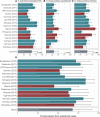Estimating the contribution of subclinical tuberculosis disease to transmission: An individual patient data analysis from prevalence surveys
- PMID: 38109277
- PMCID: PMC10727500
- DOI: 10.7554/eLife.82469
Estimating the contribution of subclinical tuberculosis disease to transmission: An individual patient data analysis from prevalence surveys
Abstract
Background: Individuals with bacteriologically confirmed pulmonary tuberculosis (TB) disease who do not report symptoms (subclinical TB) represent around half of all prevalent cases of TB, yet their contribution to Mycobacterium tuberculosis (Mtb) transmission is unknown, especially compared to individuals who report symptoms at the time of diagnosis (clinical TB). Relative infectiousness can be approximated by cumulative infections in household contacts, but such data are rare.
Methods: We reviewed the literature to identify studies where surveys of Mtb infection were linked to population surveys of TB disease. We collated individual-level data on representative populations for analysis and used literature on the relative durations of subclinical and clinical TB to estimate relative infectiousness through a cumulative hazard model, accounting for sputum-smear status. Relative prevalence of subclinical and clinical disease in high-burden settings was used to estimate the contribution of subclinical TB to global Mtb transmission.
Results: We collated data on 414 index cases and 789 household contacts from three prevalence surveys (Bangladesh, the Philippines, and Viet Nam) and one case-finding trial in Viet Nam. The odds ratio for infection in a household with a clinical versus subclinical index case (irrespective of sputum smear status) was 1.2 (0.6-2.3, 95% confidence interval). Adjusting for duration of disease, we found a per-unit-time infectiousness of subclinical TB relative to clinical TB of 1.93 (0.62-6.18, 95% prediction interval [PrI]). Fourteen countries across Asia and Africa provided data on relative prevalence of subclinical and clinical TB, suggesting an estimated 68% (27-92%, 95% PrI) of global transmission is from subclinical TB.
Conclusions: Our results suggest that subclinical TB contributes substantially to transmission and needs to be diagnosed and treated for effective progress towards TB elimination.
Funding: JCE, KCH, ASR, NS, and RH have received funding from the European Research Council (ERC) under the Horizon 2020 research and innovation programme (ERC Starting Grant No. 757699) KCH is also supported by UK FCDO (Leaving no-one behind: transforming gendered pathways to health for TB). This research has been partially funded by UK aid from the UK government (to KCH); however, the views expressed do not necessarily reflect the UK government's official policies. PJD was supported by a fellowship from the UK Medical Research Council (MR/P022081/1); this UK-funded award is part of the EDCTP2 programme supported by the European Union. RGW is funded by the Wellcome Trust (218261/Z/19/Z), NIH (1R01AI147321-01), EDTCP (RIA208D-2505B), UK MRC (CCF17-7779 via SET Bloomsbury), ESRC (ES/P008011/1), BMGF (OPP1084276, OPP1135288 and INV-001754), and the WHO (2020/985800-0).
Keywords: Mtb transmission; asymptomatic transmission; asymptomatic tuberculosis; epidemiology; global health; household Mtb infection surveys; human; infectious disease; mathematical modelling; microbiology; subclinical transmission.
© 2023, Emery et al.
Conflict of interest statement
JE, SB, BF, FG, KH, SH, IL, Fv, HN, HN, MQ, AR, ET, RW, KZ, FC, RH No competing interests declared, PD has received consultancy fees from WHO (TB burden estimation) and participates as chair of SAB for NIHR grant on TBI screening. The author has no other competing interests to declare, GM acts as President of the International Union Against TB & Lung Disease. The author has no other competing interests to declare, IO has received grants from National TB Program Cambodia, WHO and DFAT (Australia) and has received consulting fees from WHO Myanmar Office. The author is on the Board of the Directors, UNION IUATLD and WHO’s Global Task Force on TB Impact Measurement. The author has no other competing interests to declare, NS received a grant from the Bill and Melinda Gates Foundation and owns stock/stock options in Sanofi Aventis Pharma LTD. The author has no other competing interests to declare
Figures













Update of
References
Publication types
MeSH terms
Grants and funding
LinkOut - more resources
Full Text Sources
Medical
Miscellaneous

